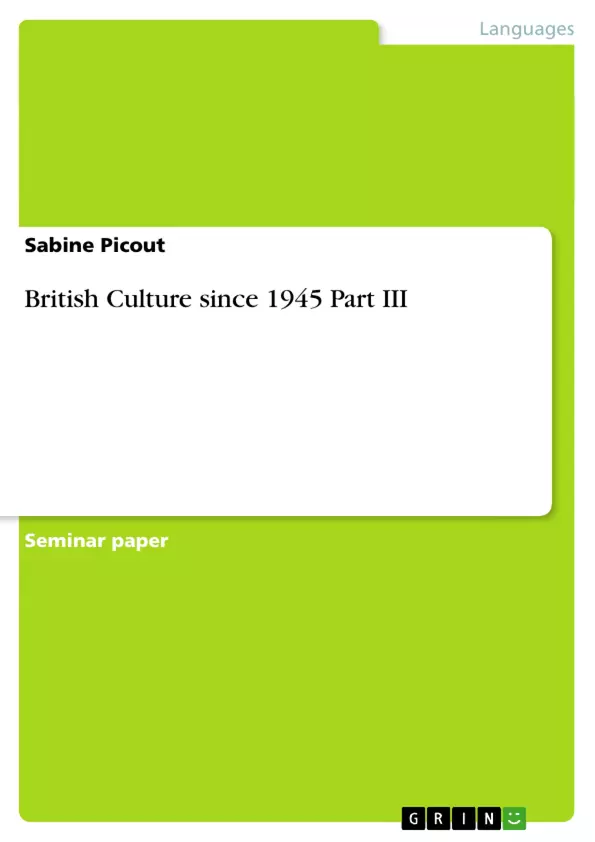The idea came from plans to celebrate the midpoint of the century and at the same time the centenary of the Great Exhibition (of arts and merchandise) in 1851 to show the whole world Britain’s wealth and power. It was a time when Britain had begun to over come the consequences of World War II. The Festival was a symbol of hope for the whole nation and marked the end of austerity and the beginning of wealth. The Royal Festival Hall is on the south bank of the River Thames. It was constructed for the Festival in Britain, opened in 1951 and seats nearly 3000 people. A lot of concerts with international orchestras but also literary works are performed in this concert hall and a lot of exhibitions take place in this building.
The Festival of Britain 1951 and The Royal Festival Hall are mentioned in Hare’s play “Plenty” ( further information on David Hare: view presentation).
Scene four of the play takes the audience to the Festival of Britain. This scene takes place on May 4, 1951, the opening day of
the Festival. The Festival was a celebration of the midpoint of the new century and of the centenary of the Great Exhibition in 1851. The author describes the celebratory fireworks of the Festival. At the opening night Susan and Mick stand talking about having a child and look across the Thames.
The Festival “was a vast sprawl of exhibits covering 27 acres on the South Bank, including the newly opened Festival Hall 3 and the area where the National Theatre now stands.”
Inhaltsverzeichnis (Table of Contents)
- Representations, Realia, Examples 1945-1970 (Worksheet 3)
- From the Bomb to the Beatles
- The Festival of Britain 1951
- Notting Hill (film and script, 1999); To Sir, With Love by E.R. Braithwaite
- The War Game by Peter Watkins
- The Trial of Lady Chatterley, ed. C.H.Rolph
Zielsetzung und Themenschwerpunkte (Objectives and Key Themes)
This worksheet focuses on providing a collection of realia, representations, and examples from British culture in the period following World War II, specifically from 1945 to 1970. It aims to showcase how British culture evolved in the aftermath of the war, encompassing various facets including social, cultural, and economic transformations.
- The impact of World War II on British society and culture
- The shift from austerity to prosperity in the post-war era
- The changing landscape of cultural taste and its connection to economic and social conditions
- Key cultural events and figures that shaped the 1945-1970 period
- The role of art and literature in reflecting the changing social and political realities of the time
Zusammenfassung der Kapitel (Chapter Summaries)
- From the Bomb to the Beatles: This chapter explores the exhibition catalogue of the same name, which showcases the cultural and social transformations in Britain from 1945 to the mid-1960s. It highlights how the nation's cultural taste shifted alongside economic and social changes, moving from the austerity of the immediate post-war years to the prosperity of the 1950s and 1960s.
- The Festival of Britain 1951: This chapter examines the Festival of Britain, a celebration of the midpoint of the 20th century and the centenary of the Great Exhibition in 1851. The Festival served as a symbol of hope for the nation, marking the end of austerity and the beginning of wealth. The chapter explores the significance of the Royal Festival Hall, constructed for the event, and its role as a venue for concerts, literary works, and exhibitions.
- Notting Hill (film and script, 1999); To Sir, With Love by E.R. Braithwaite: This chapter delves into the film and novel "To Sir, With Love," which portray the challenges and triumphs of a black teacher in an East End school. The chapter analyzes how the story reflects the social realities of the period, particularly the complexities of race relations and the importance of understanding and empathy in education.
- The War Game by Peter Watkins: This chapter examines Peter Watkins' film "The War Game," a fictionalized account of a nuclear attack on Kent, England. Despite its cinematic quality, the film was banned by the BBC for its graphic depiction of the consequences of nuclear war. The chapter explores the film's critical stance toward the government's nuclear policy and its enduring relevance even after its initial censorship.
Schlüsselwörter (Keywords)
This worksheet focuses on the cultural and social changes in Britain from 1945 to 1970. Key topics include: post-war recovery, economic development, social transformation, cultural shift, cultural representation, realia, austerity, prosperity, the Festival of Britain, education, race relations, nuclear war, and censorship.
- Arbeit zitieren
- MMag. Dr. Sabine Picout (Autor:in), 2004, British Culture since 1945 Part III , München, GRIN Verlag, https://www.grin.com/document/189973



